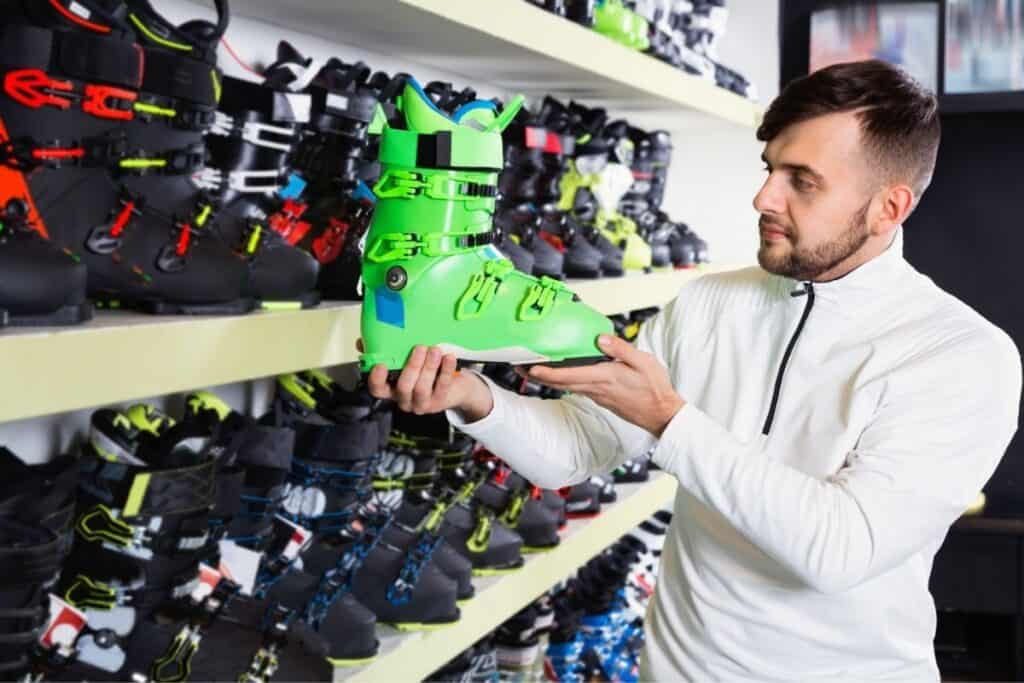
What people discuss less frequently is how vital the means of transferring energy from you to your skis are. Enter ski boots and the importance of choosing the right size and fit for you. The proper ski boots make all the difference while skiing.
According to many professional skiers, Ski boot fitting is the most critical thing to get right, but most people get it wrong. Most new skiers approach the fitting of their ski boots the way they would with hockey skates or athletic shoes.
While these both seem like intuitive approaches, they are wrong. The way ski boots fit and how you use them in conjunction with your skis means that they have to fit in a specific way!
The issue here is that most people generally do not know everything they should about ski boots and how to find the ideal fit. This article will answer anything you have ever wanted to know about ski boot fitting.
1. Do Ski Boots Come In Half Sizes?
The simple answer to this is no. Ski boot sizes are not like shoe sizes. While a pair of running shoes might come in standard sizes and half sizes, ski boots go off a direct measurement system.
The system used to measure ski boot sizes is called the mondo chart. The chart measures in centimeters from the heel to the toe of the foot that goes inside it.
What this means for you is that a ski boot should fit much more snug than an everyday shoe. A fair comparison would be figure skates; your foot should not have any wiggle room within the boot at all.
So, in essence, a more complete answer to whether or not ski boots come in half sizes is this: ski boots do not come in half sizes because the margins between each size on the mondo scale are too small to need them.
The best way to tell if your ski boots fit correctly is to try them on and base your observation on feeling. Your foot should have light contact with the inside of the toe of the ski boot. The heels and ankles should not be able to move at all once you fully buckle the boots.
The boots should also fit snuggly around the calf and shin once buckled. The hinged buckles present on ski boots should be a solid indicator of how snug they should be overall.
2. Do Ski Boots Loosen Up Over Time?
Yes, ski boots do get looser over time. Just like anything else, the repeated wear on the buckles causes them to wear down. The padding inside the boot also breaks down over time from feet sliding in and out of them, crushing the pads down.
Like any other piece of ski equipment, boots will wear down and loosen up the longer you use them. When this happens, people simply replace their existing pair with new boots.
If you are wondering if your current ski boots are too loose, they are probably still fine. Ski boots become extremely uncomfortable once they loosen up a bit.
In most cases, the trouble starts with having too much ankle room and too much flex, putting a strain on the joints and causing soreness.
More importantly, for performance, loose ski boots mean less responsive skis.
Loosening ski boots are inevitable, but they are also easily avoidable. A pair of ski boots may last you anywhere from two years to ten years, depending on how frequently you go out and ski in them.
You should always make sure that the gear you use is fully functional and relatively up to date. Worn-out ski boots can potentially ruin an entire skiing trip from either frequent falls or general discomfort in the ankles and knees from how hard it is to steer with them.
3. Do Ski Boots Run Big or Small?
It is extremely important that ski boots run true to size. Having poorly fitted ski boots can lead to numerous injuries while skiing.
If your ski boots are too big, your foot could slide around in your boot, resulting in bruising, bumps, and blisters. Your ankle bones, toes, tops of your feet, and shins are most prone to injuries if your boots are too big or too small.
A ski boot that is not the proper size can also result in more serious injuries. Things such as ankle sprains or torn ACLs are well avoided by having a boot that doesn’t run too big or too small.
In most cases, you will find that your ski boot feels a little tighter than a normal shoe. This is because most normal shoes are actually sized bigger than what we require. This is to allow a little more wiggle room and comfort in our daily routines without too much worry of injury.
Experts will sometimes choose a shell that is sized smaller than their normal shoe. This can be ½ to a full size smaller than a regular indicated size to provide a very precise fit and stiff flex.
You should always find a boot that fits a little snuggly, but not so much so that it will cut off circulation. If you have any concerns, always ask an expert before purchasing to ensure you will reduce the risk of injury.

4. How Tight Should a Ski Boot Be?
Building off the last point, when choosing ski boots, considers that they will loosen a bit over time. As a general rule, ski boots should be as tight as possible without restricting circulation through clothing.
A question about how tight a ski boot should be is how much flex the boot should have. A ski boot should have less flex if a person is heavier or more skilled at skiing.
Boots with a flex between 30 and 100 are best suited for adult men at an intermediate skill level.
Variations abound from this example, but it does give a reasonable baseline for understanding how to judge the flex of a ski boot and if yours are tight enough for safe and comfortable use.
An in-person ski boot fitting session is the best way to identify the exact ski boot fit you will need while out shredding.
It’s always important to get the ski boots tight enough for you to control the skis. More advanced skiers tend to prefer tight boots because it gives them more control over their skis.
Tight boots allow you to make sharper turns and steer your body around obstacles quicker. Many advanced skiers look back and say that they spent a long time getting the wrong measurements for their boots.
5. Do Ski Boots Shrink in The Cold?
Ski boots do not shrink in the cold because that would be wildly counterintuitive to how you use them. However, your feet will shrink a little bit in the cold if you are not careful.
Feet may grow from the increase in blood flow from being on them for a long time, something runners are well aware of, but they can also shrink from contact with snow or just cold temperatures.
The plastic and synthetic fabrics ski boots are made of are designed to be cold resistant and prevent shrinkage, but they are not necessarily entirely waterproof.
Typically, you are not in direct contact with snow in the same way you would be while mountain climbing, but new skiers who are more prone to falling run the risk of getting snow in their boots.
In these cases, other articles of clothing such as thick water-resistant socks are great to have.
Another important facet of both ski boot fit and keeping your feet warm is choosing the right socks and the correct number of socks. Many people advocate for doubling up on socks while out in the cold.
This is a bad idea. Doubling the layers of socks on your feet reduces the airflow to them and makes them sweat. Sweaty feet get cold quicker, but the extra fabric also affects the fit of the ski boots you are wearing, which can cause other discomforts.
Conclusion
Choosing the right fit for your ski boots is by far the most crucial aspect of having a successful ski trip. Your ski boots have an impact on how comfortable you are while skiing as well as how well you can maneuver your skis.
Ski boots are measured using the mondo system, ensuring accurate measurement of the person’s foot and a perfect snug fit.
The other details of the ski boot and how it should fit come down to your weight and skill level. Once again, ski boots are not the same as ice skates or running shoes in terms of what you want out of the fit.
If you are ever unsure about your ski boots’ fit, a trained ski boot distributor will be well-versed in fitting the proper ski boots to your feet and making sure your skiing experience is all that it can be.
Related Articles
If you found this article helpful, then make sure to take a look at some of my other related articles linked below!
